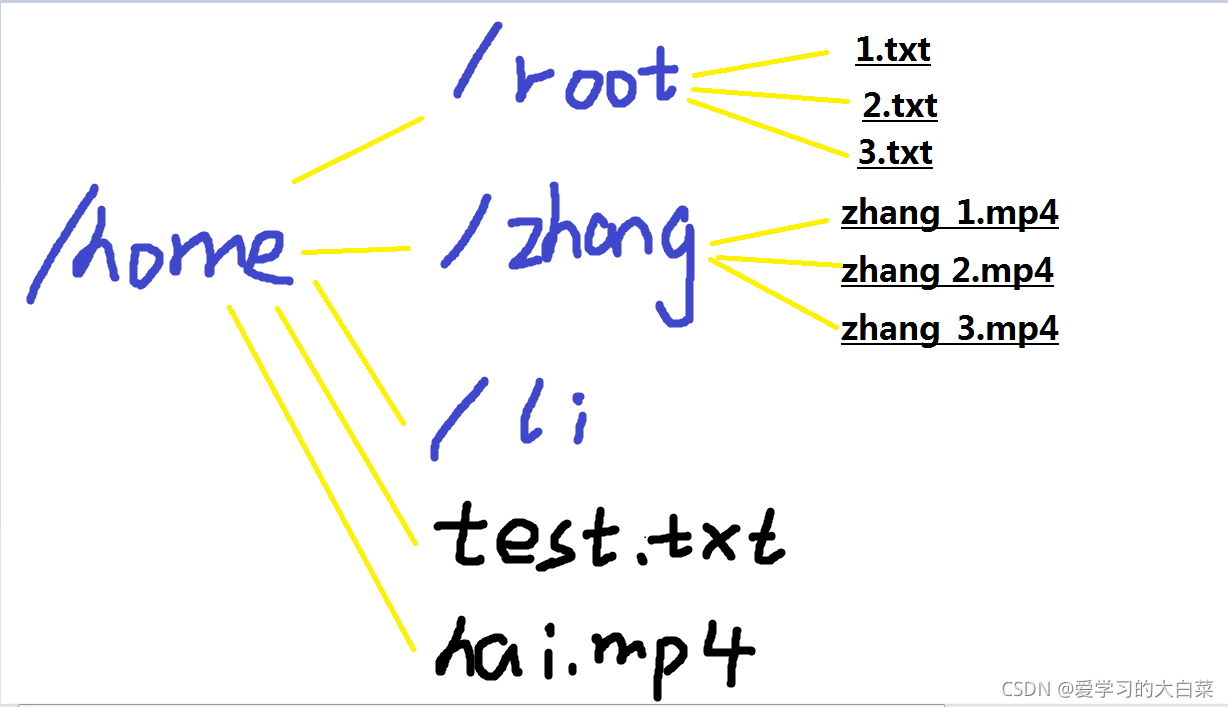os.walk()是一种遍历目录数的函数,它以一种深度优先的策略(depth-first)访问指定的目录。
其返回的是(root,dirs, files),
- root代表当前遍历的目录路径,string类型
- dirs代表root路径下的所有子目录名称,list类型,列表中的每个元素是string类型,代表子目录名称。
- files代表root路径下的所有子文件名称,返回list类型,列表中的每个元素是string类型,代表子文件名称。
加入我当前的目录如下。

可以先打印一下其是怎么遍历的:
|
1
2
3
4
5
6
7
8
9
|
import osfrom os.path import joinhome_path = "/home"for (root, dirs, files) in os.walk(home_path): print(root) print(dirs) print(files) print("=" * 50) |
输出如下:
/home
['root', 'zhang', 'li']
['test.txt', 'hai.mp4']
==================================================
/home/root
[]
['1.txt', '2.txt', '3.txt']
==================================================
/hoome/zhang
[]
['zhang_1.mp4', 'zhang_2.mp4', 'zhang_3.mp4']
==================================================
/home/li
[]
[]
==================================================
一共三行,
第1行代表当前遍历的目录,我们称为root目录,
第2行代表root目录下的子目录列表,我们称为dirs,
第3行代表root目录下的子文件列表,我们称为files,
上面的列表为空就代表当前遍历的root目录下没有子目录或者没有子文件。
另外,如果我想遍历home目录下所有的目录和文件的绝对路径,则直接用os.path.join()方法对 子目录或子文件名 和 root目录 进行拼接即可,则代码如下:
|
1
2
3
4
5
6
7
8
9
|
import osfrom os.path import joinhome_path = "/home"for (root, dirs, files) in os.walk(home_path): for dir in dirs: print(join(root, dir)) for file in files: print(join(root, file)) |
输出:
/home
/home/root
/home/zhang
/home/li
/home/test.txt
/home/hai.mp4
/home/root/1.txt
/home/root/2.txt
/home/root/3.txt
/home/zhang/zhang_1.mp4
/home/zhang/zhang_2.mp4
/home/zhang/zhang_3.mp4
到此这篇关于python 中 os.walk() 函数的文章就介绍到这了,更多相关python os.walk() 函数内容请搜索服务器之家以前的文章或继续浏览下面的相关文章希望大家以后多多支持服务器之家!
原文链接:https://blog.csdn.net/csdnliwenqi/article/details/121065487










